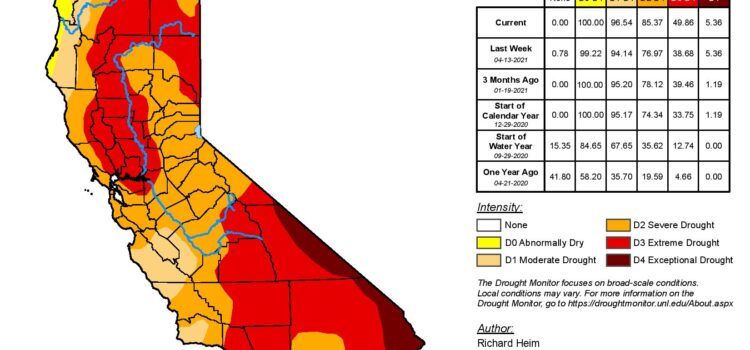
California is in the midst of its second consecutive dry year, pushing the state to the brink of another drought.
The winter months are supposed to be the wettest for the state of California – but not this year, as 100 percent of the state is experiencing abnormally dry conditions and 85 percent of the state is experiencing severe drought conditions, according to the United States drought monitor.
As of now, Governor Gavin Newsom has only declared a drought emergency in two counties, Sonoma and Mendocino, and has directed state agencies to bolster drought resilience and prepare for impacts on communities, businesses and ecosystems if dry conditions extend to a third year.
“California is facing the familiar reality of drought conditions,” Newsom said in a press release on April 21. “And we know the importance of acting early to anticipate and mitigate the most severe impacts where possible.”
While the western part of Kern County is severe drought conditions, the eastern side is experiencing extreme drought conditions. Consequently, Kern County’s water supply from the State Water Project has been reduced to just five percent of full allocation due to low water storage and rainfall.
Ranking second in types of phenomena that are associated with billion dollar weather disasters, the impacts of droughts are proven to be extremely hazardous and have substantial societal, environmental, and socioeconomic risks. These risks include farmers losing money due to crop destruction, ranchers spending more money to feed and water their animals, plants and animals losing their habitats, the damaging of people’s health and safety, and a substantial increase in wildfire risk.
Californians are encouraged to reduce water use and conserve supplies in case these dry conditions extend into next year. Newsom’s state of emergency proclamation revealed that the governor has directed state agencies to work with regional and local governments to to identify watersheds, communities, public water systems and ecosystems that may require coordinated state and local actions to address drought impacts and protect people, natural resources and economic activity.
“Climate change is intensifying both the frequency and the severity of dry periods. This ‘new normal’ gives urgency to building drought resilience in regions across the state and preparing for what may be a prolonged drought at our doorstep,” Newsom announced last Wednesday.
Under the Drought Resilience Task Force, state agencies have been able to work together since November to prepare for continued dry conditions. Alongside the emergency proclamation made by Governor Newsome, state agencies have also taken various actions to address dry conditions including the launching of a new drought preparedness website that details current conditions, the state’s response, and informational resources for the public.